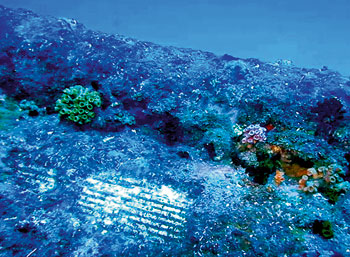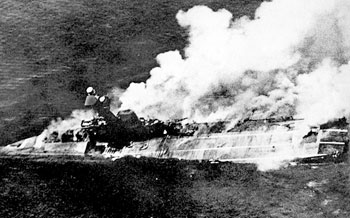Lying in its watery grave, at a depth of a little over 50 meters off the East coast, the world's first aircraft carrier, HMS Hermes is Sri Lanka's star shipwreck.
Sunk by Japanese bombers during World War II, it is now attracting serious attention of both local and foreign divers. But there came disturbing news, where a recent investigation by the National Aquatic Resources Agency (NARA) has found attempts to remove one of the cannons off this wreck.
Photographs by NARA's underwater survey team chief Lucky Ginige show attempts to remove artefacts from the Hermes and the exposed data plate of one of her guns.
Divers who explored the Hermes shipwreck say the main tower of Hermes broke at the impact of sinking, but overall, most of the ship is intact. Several anti-aircraft guns, including a few canons are among the key features of the wreck that attract divers worldwide to this iconic shipwreck. Therefore, this shipwreck is a star attraction of Sri Lanka's dive-tourism, and dive operators highlight the need to preserve its present status.
In recent months, especially after the war, many shipwrecks have been salvaged for their scrap metal and artefacts. Plans are afoot for the salvage of many more sunken ships, but it is not prudent, point out marine experts, as these shipwrecks have become artificial Coral Reefs that support a variety of marine life.
 |
| The Hermes wreck is covered in large black corals, with large schools of snapper
and barracuda, along with some potato cods and lots of dogtooth tuna |
NARA biologist and diver Arjan Rajasuriya who made several dives on the Hermes, observed that the wreck is covered in large black corals, with large schools of snapper and barracuda, along with some potato cods and lots of dogtooth tuna.
Like the Hermes, most of the other shipwrecks too support the livelihood of fisher folk who rely on colonies housed in these wrecks. But some wrecks are also threatened by destructive fishing methods such as blast fishing using dynamite.
To safeguard these treasures, NARA has moved to take effective measures for protecting our wrecks as fisheries, cultural/archaeological, historical and tourism resources which could be of value for centuries to come, said its chairman Dr. Hiran Jayawardene.
Last year, NARA attempted to set up an inter-ministerial committee on wrecks, through a Cabinet memorandum by Fisheries Minister Rajitha Senaratne.
Dr Jayewardene said that NARA has revived its 1980's programme on wrecks, and is preparing an inventory of all wrecks for long-term management under the Marine Spatial Data Infrastructure (MSDI) established by the Agency.
NARA's National Hydrographic Office Director M.A. Ariyawansa said Bathymetric profiles are now being obtained of the wreck sites with special equipment, as well as baseline records for periodic monitoring.
Scientists have begun the study of fish populations, so that their dynamics could be better understood for developing future management regimes. Encouraging tourist access, while at the same time preventing the removal of artefacts, will have to be addressed. NARA, along with the Department of Wildlife Conservation (DWC), is developing a legal framework and network of marine protected areas.
Though a management plan of wrecks was sought within a month, in March this year, the related report has been delayed by bureaucracy, according to concerned parties.
Once more, the salvage 'pirates' are lobbying politicians for salvage permits to cannibalise these wrecks, many of which have already been plundered, both legally and illegally. If plundered, salvage will benefit a few briefly, and the wrecks lost to future generations, highlights this report. So it is the need of the hour to protect these invaluable wrecks for posterity viz, fisheries, cultural, archaeological, historical and tourism resources.
HMS Hermes: Factfile
HMS Hermes was the first purpose built aircraft carrier the world had seen, built in 1918 and commissioned in 1923.
 |
| HMS Hermes under attack in April 1942 |
She distinguished herself in the Far East, which eventually ended in April 1942, when she was caught by aircraft from the Japanese Carrier Fleet from Pearl Harbour. Ships that would meet their own violent end at the Battle of Midway, just two months later.
At 11 am on April 9 1942, with her covering fighters and obsolete torpedo/bomber biplanes ashore, dispersed to airfields and then destroyed in earlier Japanese air raids over Ceylon, HMS Hermes’ three high angle 4.5” anti-aircraft guns, and six 20mm cannons were quickly overwhelmed and knocked out.
After 40 or more direct hits by 70 Dive Bombers, she sank rapidly. In a battle lasting only 15 minutes, 307 men were killed.
NARA chief Hiran Jayewardene said that in the 1980s, the late Rodney Jonklass, who actually discovered the wreck many years previously, was the first to dive on it. He made several dives on the Hermes for NARA, in the initial stages. |



